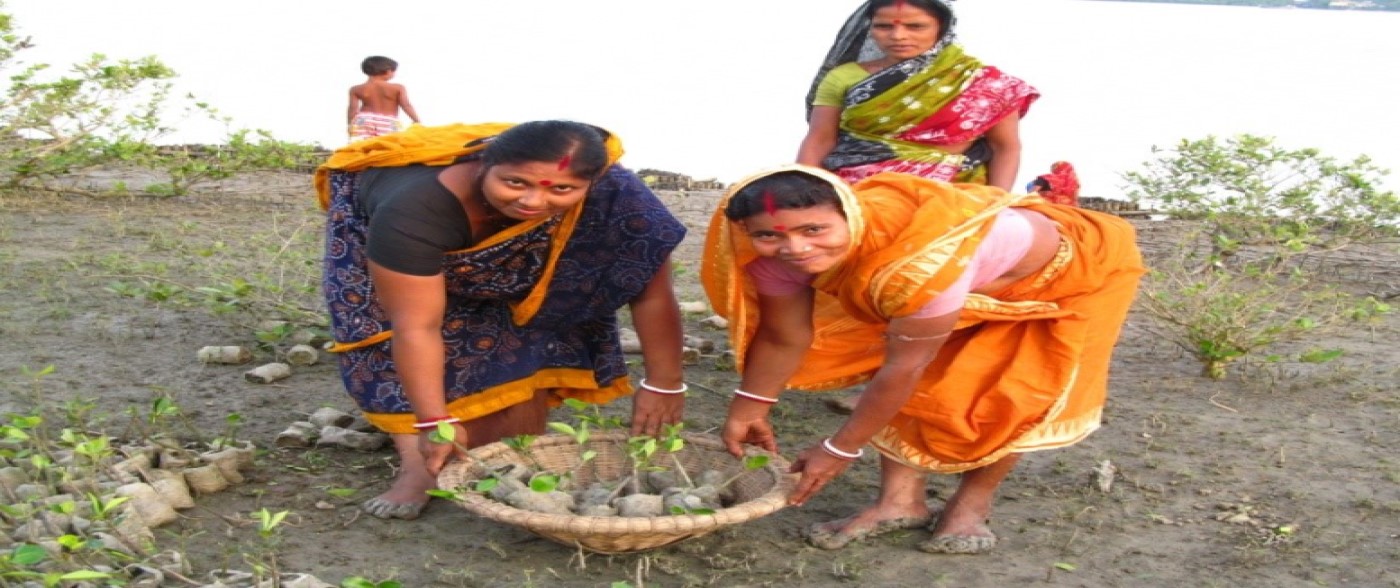Livelihood > Agriculture
<< Back To CategoryDue to its topographical uniqueness, Sunderban is disadvantaged in terms of conventional agricultural practice due to several reasons. These are:
-
Naturally being an low lying area, inundation and water logging is common affecting production
-
High saline content in land affects productivity
-
Dearth of irrigation facilities & dependence on ground water for agriculture that effect affect ground water reserves as well as an expensive practice that few can afford
-
In addition rapidly increasing incidences of natural disaster coupled with high rate of soil erosion pose further challenges to agriculture as the prime livelihood of the region.
Economically disadvantaged, the vulnerability of the community in face of natural disaster is magnified manifolds. Hence the land shaping model of integrated farming has been undertaken to take on the issues head on. The strategy addresses the challenge on following fronts:-
Agriculture: Provides scope for utilizing small land holdings beyond the traditional option of single crop (aman crop of monsoon) through cultivation of high yielding varieties including vegetables. Promotes usage of organic fertilizers reducing input cost and helping ecology.
Environment: Excavation of a reservoir that harvests rain water reduces dependence on ground water for agricultural purpose. The reserved water helps to replenish ground water reserves.
Low lying land: The soil excavated from the reservoir elevates the height of the land
Land Usage: Integrates fishery and duck rearing in the water of the reservoir providing further economic viability to land use. The waste feed of the duck supports the fishes.
The culmination of the entire activity is aimed at improving the economic condition of poor families with small land holding thereby minimizing distress migration in search of livelihood. While providing such an option, the activity simultaneously promotes environment friendly agricultural practices that further the core values of environmental health. Thus marginalized landowners who have unproductive, salinity affected land are offered input, technology and ancillary assistance to develop their land to be disaster resilient.
Economic stability for the majority of population languishing in poverty is the best approach to increase community capacities and resilience and minimize the vulnerabilities to various disasters as well as distress migration. Building a disaster-resilient community focusing on disaster risk reducing interventions is a key strategy in capacitating people to manage calamities and disasters. It also maximizes the use of limited resources in the community and ensures that the community is prepared for any eventuality. Land and water being the scarcest resources of the region, attracts the thrust of intervention under the scope of the current project.
In Sundarbans, the rainy season is longer with 1,750 mm of average rainfall; In 90 per cent of the cultivated land, water level remains above 30 cm. and up to 100 cm. during peak monsoon months. It is impossible to grow any crop except the low yielding variety. This barely meets the needs of the families. Cultivation of High Yielding variety (HYV) of rice is not possible due to high water stagnation and poor drainage. Double or multiple cropping with winter vegetables is not feasible as the field remains engaged till December-January for aman cultivation. After January, with increase in temperature, soil salinity also increases leading to poor seed germination and crop growth. Available fresh water is not sufficient for irrigation either during summer or for winter season crop. Therefore, in Sundarbans, though water is everywhere, it is useless and indeed it is the cause for widespread poverty in the area.
SSDC undertook the activity of Land Shaping wherein a part of the land is raised artificially. The idea of digging ponds to raise the low land with the help of excavated earth provided sufficient rain  water for crop irrigation as well as prevented water stagnation. This made it suitable for the cultivation of HYV rice, vegetables etc. Land Shaping combined with the Integrated Farming Systems Approach is one of the main factors for enhancing productivity in a sustainable way in the Sundarbans.
water for crop irrigation as well as prevented water stagnation. This made it suitable for the cultivation of HYV rice, vegetables etc. Land Shaping combined with the Integrated Farming Systems Approach is one of the main factors for enhancing productivity in a sustainable way in the Sundarbans.
Instead of cultivating only rice and keeping the land fallow for more than six months, through land shaping the plots are converted to yield diverse harvests of 10 -12 ty pes of crops per year. Because of erratic monsoons, failure of rice crop was frequent earlier but now the incomes are generated in different seasons and other activities like fish, poultry, duck rearing and horticulture.
pes of crops per year. Because of erratic monsoons, failure of rice crop was frequent earlier but now the incomes are generated in different seasons and other activities like fish, poultry, duck rearing and horticulture.
The land is used for growing rainy season vegetables like lady's finger, cucumber, etc and also used to grow pulses or early mustard in the muddy soil as 'relay crop'. In winter season, the winter vegetables like tomato, spinach, beans etc are grown. Besides tradit ional rice varieties in the monsoon season, the low land is cultivated with chilly, bitter gourd, sunflower in summer season with the irrigation water from the pond.
ional rice varieties in the monsoon season, the low land is cultivated with chilly, bitter gourd, sunflower in summer season with the irrigation water from the pond.
Through Land Shaping, the annual income from agriculture will increase to meet nutritional requirements of the families and also generate additional income, making distress migration and ecologically damaging livelihoods like wood cutting and prawn fingerling collection unnecessary. With the production of different vegetable, pulses, eggs, fruits like papaya, guava provides nourishing food for the family is assured. Children will get increased scope to enroll in schools and women of the family will find engagement in the gardening, duck rearing etc.







